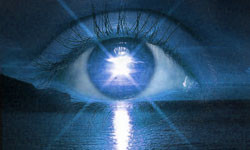I want to clarify how to look at adjacent details better. I described this specific method in my last blog post about looking at adjacent details. The idea here is to learn to shift your attention the shortest distance possible, corresponding to the smallest possible eye movement. And the shortest distance possible is going to be the distance between the two smallest points you can perceive that are right next to each other, or almost no distance at all. So basically you’re working your way through a string of details. It’s a string formed by a single line of pixels, or dots. The string isn’t necessarily straight, because of course the things you look at come in all shapes. As you work your way along the string, you are trying to not skip over any of the dots of detail. So each detail is immediately next to the previous one.
As you do this, you’ll find that it can only be done when you look at small enough details. Being able to do that is just an adjustment in perception, and it’s done by conscious choice. It may take some time to do it very effectively, over weeks and months, but right away you should notice that perceiving blur as countless tiny details does make a difference in what it looks like. It won’t look better at first. It will look worse, more confusing, with multiple scattered images. But that’s where you have to start. It’s simply about being honest with yourself about exactly what you see, down to each piece.
As I’ve described before, you need to consider everything, whether it’s blur or a clear image, as made up of tons of tiny details or pixels.
You can practice this with a close up object in your hand, if you’re nearsighted. Distance makes no difference. The right way to see is done the same close up as at a distance.
If you find your attention jumping away, remember that the large jump is directly caused by your eyes making too large of a movement. As a parallel, consider what happens when you try to hold the tip of your finger just above the table surface in front of you while keeping your finger as still as possible, with an absolute minimum of trembling. If you tense your hand up to try to force it still, it will tremble a certain amount. You will find that the only way to get your finger as still as possible is by relaxing your hand as much as possible. If you do so, you will notice it trembling far less than what it was when you clenched your hand. The eyes are no different. The movements can be small if you calm them. This is a specific application of where and how to apply the concept of relaxation. It’s confusing or misleading when we talk about “relaxing the eyes” unless we nail it down to a specific example like this.
After a short moment you can jump to another string. And you’re creating the path of the string as you follow it, so it can be anything and anywhere. You aren’t necessarily tracing the outline of anything or following any particular color, but moving in any direction as the string changes colors.
Jumping to another spot is a normal part of seeing. But in order to make jumping an effective part of your visual process, you need to learn how to move your attention through a small connected area/string without jumps.
What I’d like to do is get this down to a complete guide with not many missing pieces. It would include lots of things saying that if this happens, do this. Or if this happens, do this. I think this can be done, but I need to gather more feedback from people working with this to get a better idea of the problems people encounter.
There are tons of vision improvement programs out there that are sold or taught today, many heavily based on the Bates method or taught pretty much exactly as it’s laid out in Bates’s material. But so far as I’ve seen, none are presenting it anything close to what I’m trying to do, so there isn’t a whole lot of data to work with yet. Teaching programs are based on analyzing the results of a large number of cases. So I’m just kind of winging it here and trying not to jump to conclusions.
get help on our Facebook Group!

I founded iblindness.org in 2002 as I began reading books on the Bates Method and became interested in vision improvement. I believe that everyone who is motivated can identify the roots of their vision problems and apply behavioral changes to solve them.
